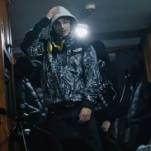Perhaps wisely, writer-director Cameron Crowe chooses not to show Lloyd and Diane’s “first date,” during which they ostensibly ate lunch together at a mall. (More accurately, they ate sitting across from each other, separately.) On the basis of this tenuous connection, however, he decides to ask her out on a real date, despite warnings from his two best friends—both female—that Diane Court doesn’t go out with guys like him, or with anyone. When her father answers the phone (the movie predates cell phones; presumably this is no longer much of an issue), Lloyd leaves a message, making note of their nonexistent first date. The scene in which Diane politely returns his call, not really knowing who he is and with no intention of accepting any offers he might make, provides John Cusack, in what became his signature role, with the opportunity to demonstrate how romantic cold calling might work, and how the very qualities that would seem to make a person unattractive can in fact be strangely alluring.
Unfortunately, my single favorite Lloyd-is-anxious moment occurs in the earlier scene, when, preparing to call Diane, he pushes six of her seven digits, then pauses to slick back his hair before pushing the seventh, momentarily forgetting that she won’t be able to see him. (Or maybe he just needs to look good in order to feel good.) Cusack revs the manic energy back up, though. Again, today Lloyd would be using a cell phone, and the scene would lose an essential quality; the fact that he has to carry that old-style square phone body around with him, constantly tripping over the cord as he paces anxiously around the room, speaks volumes about his character. He switches the body from hand to hand. He switches the handset from ear to ear. He sits down, then almost immediately stands up again. He puts the body of the phone down on the table, then almost immediately picks that up again. Meanwhile, Diane scarcely moves a muscle, and Crowe shoots her almost exclusively in the same medium close-up throughout—a model of stillness. It’s not an especially subtle way of establishing that the two are superficial opposites, but it’s plenty effective.
What’s more, Lloyd never stops talking. Cusack plays him as a guy who keeps rushing words into the vacuum for fear that the listener might have a chance to object if he ever pauses for breath. When I’m not actually watching Say Anything…, I tend to remember Lloyd Dobler as an incredibly cool guy, and he is cool in some respects. He’s anything but cool in this scene, though, which is what’s so endearing. Slowly but steadily, he wins Diane over through sheer hyperactive persistence. His use of the adverb “monumentally” amuses her enough to make her slightly recant what’s clearly her standard-issue excuse for shooting potential suitors down, as she admits that she’s not that busy. The decisive moment, though, comes when Lloyd offers to provide her with tips about living in England… and then, when she hesitates, immediately retracts the offer and promises not to give her tips of any kind. Significantly, the movie is honest enough to show Diane starting to regret agreeing to the date just seconds later, as Lloyd asks the worst possible question (“You will? Really?”) and then characterizes the evening as a “scam” (a term he’d learned from one of his friends in an earlier scene, apparently defined as a date disguised as friendship).
What Diane is responding to when she agrees to go out with Lloyd is hard to articulate, even though I think I understand her abrupt decision. On paper, nothing he says is especially witty or charming, and the fact that he seems ready to conform to whatever he thinks she wants could make him seem desperate. (People are said to be attracted to confidence, and there’s nothing confident about reversing yourself the instant you think you perceive uncertainty.) In a way, there’s a thin line between his behavior here and the classic scene in Swingers that sees Jon Favreau leave half a dozen consecutive, increasingly pathetic messages on a woman’s answering machine until she finally tells him never to call her again. Yet Cusack succeeds in making Lloyd’s nervousness seem not just cute but almost downright heroic. That the character is only 19 years old surely helps somewhat (Cusack was 22 or 23), but there’s also an appealing humility to Lloyd, which will become more apparent later in the film but is clearly detectable even here. Mostly, though, Diane detects the possibility of fun, which is not something she’s had much of so far in life. What might come across as desperation from someone else gets interpreted as an eagerness to please.
One touch that I’ve always really liked is Diane looking Lloyd up in the school yearbook right after she hangs up. Ione Skye isn’t a great actress—she’s mightily outclassed in this film by both Cusack and John Mahoney, who plays her father, and nearly all of her scenes place her opposite one or the other—but she underplays Diane’s reaction to the yearbook photo nicely, seeming neither pleased nor perturbed. It’s somehow clear that Diane wasn’t checking to see whether he’s good-looking, but was curious to see if she would recognize him; either she doesn’t, or she does but has no associations with his face that merit changing the expression on hers. Basically, she’s in shock: What did I just do? Why didn’t I call Richard, who saw my picture in the paper, or Dave, who’s into my scene? (Strangely, Lloyd’s number has a standard fake 555 prefix, but Richard’s number, visible just below it, does not. Feel free to crank-call!) It’s an inauspicious beginning, but recognizing that great romances often begin inauspiciously is one of the things that make Say Anything… special. Sometimes a bundle of nerves calls, and you just take the plunge.








































